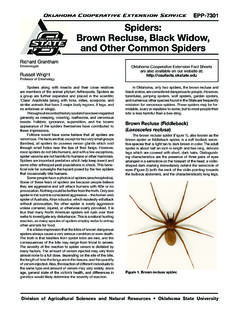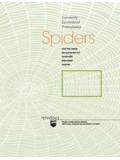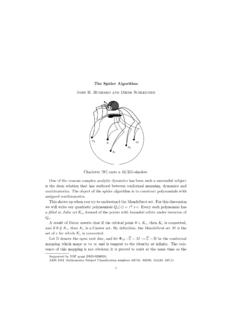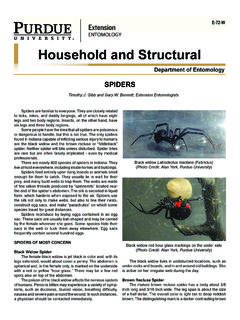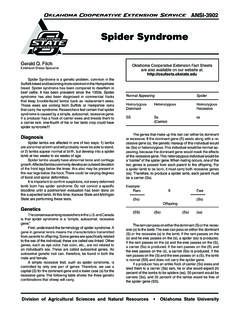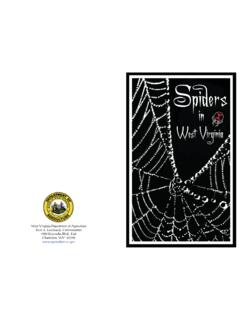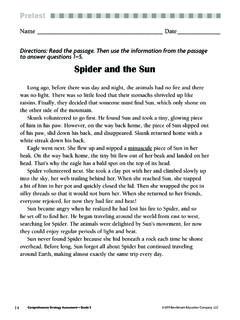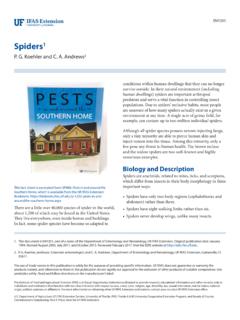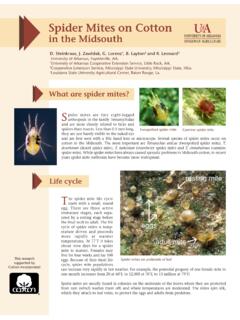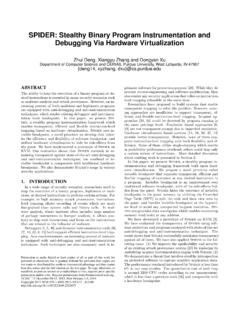Transcription of Spider Identification Guide
1 Spider Identification GuideGerald S. Wegner, , BCES piny Orbweaver, Gasteracantha cancriformisSpider Facts: Frequently Asked Questions ..3-4 Spider Anatomy ..5 Spider Key ..6-7 Spider Management In and Around Buildings ..8-9 SpidersIdentification, Distribution, Biology and Pest StatusCobweb Spiders/Combfooted Spiders ..10-11 Hourglass Spiders/Widows ..12-13 Cellar Spiders ..14-15 Brown Spiders/Violin Spiders ..16-17 Running Crab Spiders/Bark & Flower Crab Spiders ..18-19 Giant Crab Spiders ..20-21 Sac Spiders ..22-23 Ghost Spiders ..24-25 Ground Spiders ..26-27 Jumping Spiders ..28-29 Wolf Spiders ..30-31 Wandering Spiders ..32-33 Nursery Web Spiders ..34-35 Hackledmesh Spiders ..36-37 Crevice Weavers ..38-39 Funnelweavers ..40-41 Cell Spiders & Tube Spiders.
2 42-43 Tarantulas/Hairy Mygalomorphs ..44-45 Orbweaver Spiders ..46-47 Garden Spiders ..48-49 Longjawed Orbweavers & Orchard Orbweavers ..50-51 Nephilid Orbweavers ..52-53 Biography/Acknowledgements ..54 Photography Credits/References & Resources ..55 Table of Contents3 Spider Facts: Frequently Asked Questions How do spiders differ from other arthropods? All spiders have two body regions (cephalothorax and unsegmented abdomen), eight legs (each with seven segments), a pair of pedipalps, a pair of chelicerae (jaws) and either six or eight simple eyes .Are all spiders poisonous? Yes - to their prey! All spiders have a pair of poison glands with ducts that supply venom to the hollow jaws (chelicerae) . Spiders inject venom and/or digestive juices into live or recently-killed prey in order to feed.
3 Relatively few spiders are dangerous to humans .Are harvestmen (garden daddy-long-legs) spiders? No . Harvestmen, or garden daddy-long-legs (Order Opiliones), have three broadly-joined body regions (head, thorax, and a segmented abdomen), one pair of eyes and are non-venomous . They feed on vulnerable insects and plant juices .How many different spiders are there worldwide? Over 37,000 species of spiders have been described worldwide .How many species of spiders are found in North America north of Mexico? Nearly 1,000 species of spiders have been found in the continental U .S . and Canada, many of which were introduced from Europe .What is the largest Spider ? The world s largest Spider is the South American goliath bird-eating Spider , Theraphosa leblondi (Mygalomorphae: Theraphosidae).
4 Adults may attain a body length of 4 .8 inches (12 cm), a leg span of nearly 13 inches (30 cm) and a body weight of 5 .6 ounces (160 g) .What is the smallest Spider ? The smallest spiders on record belong to the Family Symphytognathidae . Anapistula caecula (Ivory Coast, West Africa) females have an adult body length of 0 .018 inches (0 .46 mm); while Patu digua (Columbia, South America) males have an adult body length of 0 .015 inches (0 .37 mm) .4 Spider Facts: Frequently Asked Questions How well can spiders see? All spiders have simple eyes . Most spiders have poor vision merely able to distinguish light from darkness and nearby movement . However, some (e .g ., jumping spiders) have excellent short-range vision and are able to distinguish shape and color.
5 Which Spider s venom is the most dangerous? The bite and venom of the Sydney funnelweb Spider , Atrax robustus (Mygalomorphae: Hexathelidae), of Austrailia is considered to be one of the most life-threatening . Some sources claim that certain Brazilian wandering spiders, Phoneutria species (Araneomorphae: Ctenidae), have the world s most toxic Spider venom .How can you distinguish between female and male spiders? Most female spiders have a copulatory portal called an epigynum, uniquely-shaped for each species, located centrally on the underside of the abdomen . Males have (species-unique) pedipalps with enlarged tips, giving them a boxing glove appearance . Females generally have larger bodies (especially abdomens) than males . Males of some families have the first pair of legs longer and/or more stocky and hairy in proportion to their size.
6 Do all spiders spin webs? Not all spiders spin webs for the purpose of capturing prey . Spiders may capture prey in three distinct ways: (1) ensnarement, assisted by a silken web comprised in part of sticky strands, (2) active hunting, while roaming about and exploring their surroundings, and (3) passive hunting concealed or stealthily awaiting the approach of unwary prey . How do spiders get on the roofs of tall buildings? In order to disburse themselves from the egg sac, newly-hatched spiderlings of some species (e .g ., orbweavers) make their way to an exposed perch and spin out long strands of silk, with which to catch a breeze . The airborne spiderlings balloon on air currents and updrafts until stopped by an obstacle . The first webs are constructed near the landing point, which may be miles away from and a considerable distance above, the point of origin.
7 How long do spiders live? Some spiders live only one year (e .g ., orbweavers), others may live two years (e .g ., wolf spiders, nursery web spiders) and still others may survive into their twenties (i .e ., some female tarantulas) .5 Spider AnatomyFangEndite ofMaxillaTrochanterof PedipalpCoxae of LegsCheliceraEyePoison GlandsCephalothoraxAbdomenAortaAttachmen tof PedicelIntestineNerveBook LungCoverEpigynum(of Females)Book LungOpenHeartDigestiveCaecaOvaryAnal TubercleSpinneretsColulusSilkGlandsAdapt ed from Levi and Levi, 19906 TRAPDOOR SPIDERS CtenizidaeTARANTULAST heraphosidaeIllustrated Key to Peridomestic Spider FamiliesChelicerae open and close directly forward and downwardMYGALOMORPH SPIDERSS uborder MygalomorphaeEight small eyes clustered at top front of carapaceFOLDING DOOR TRAPDOOR SPIDERS AntrodiaetidaeChelicerae open and close laterally and inward - scissors-likeTRUE SPIDERSS uborder AnaneomorphaeEight eyesSix eyesSome eyes clustered or groupedEyes distinctly separatedContinue on page 7 Posterior median eyes separate.
8 Lateral eyes grouped or closeEyes arranged in two groups of threeEyes arranged in three groups of two (diads)SHORT-BODIED CELLAR SPIDERSP holcidae in partCephalothorax circular & domed posteriorly; body & legs mottled, spotted or solid-coloredSPITTING SPIDERSS cytodidaeCephalothorax not domed posteriorly; abdomen and legs solid-coloredLegs glossy red or brownLegs brown and not glossyCELL SPIDERS & TUBE SPIDERSD ysderidae & SegestriidaeBROWN SPIDERS/VIOLIN SPIDERSS icariidaeAnterior median eyes separateAnterior median eyes grouped or closer than poster median eyesAbdomen, legs and jaws elongated; abdomen often with silver background colorationLONGJAWED ORBWEAVERS & ORCHARD ORBWEAVERST etragnathidae & NephilidaeCribellum not presentCribellum present; abdomen oval and not extending over cephalothoraxHACKLEDMESH WEAVERSA maurobiidaeLateral eyes grouped only; abdomen pot-bellied, globular, or spiny and extending over the cephalothoraxOne pair of eyes medially.
9 Two groups of three eyes laterallyLONG-BODIED CELLAR SPIDERS Pholcidae in partWeb irregular-shapedWeb orb-shapedCOMBFOOTED/COBWEB SPIDERS, INCLUDING HOURGLASS SPIDERS TheridiidaeORBWEAVERS & GARDEN SPIDERSA raneidae7 Eight eyes distinctly separated (continued from page 6)All eyes appear close in sizeSome eyes distinctly larger than othersCRAB SPIDERST homisidaePhilodromidaeEyes arranged in two rows of fourEyes arranged in flat oval or sideways D patternCephalothorax and legs usually not hairy but have a slightly glossy or translucent appearance; spinnerets shortSAC SPIDERSC lubionidae, Miturgidae and CorinnidaeTwo front pairs of legs curve forward; two rear pairs of legs curve backward while at rest; one pair of long spinneretsThree or four pairs of legs curve forward while at rest; spinnerets very shortFUNNEL WEAVERSA gelenidaeLateral eyes noticeably larger than median eyes; legs curve forward; adults typically largeGIANT CRAB SPIDERS/HUNTSMAN SPIDERSS parassidaeAnterior eyes larger than posterior eyesPosterior eyes widely spacedJUMPING SPIDERS SalticidaePosterior eyes in a rowCREVICE SPIDERS FilistatidaePosterior eyes larger than anterior eyesPosterior eyes much larger than anterior eyesWOLF SPIDERS LycosidaeAnterior eyes equal.
10 Posterior eyes equalPosterior eyes may be equal or posterior lateral eyes may differ in size from posterior median eyesGROUND SPIDERS GnaphosidaeAnterior spinnerets cylindrical, elongate and widely separatedSpinnerets very short; adults typically largeNURSERY WEB & FISHING SPIDERS PisauridaeAnterior spinnerets conical and closely spaced; adults not largeGHOST SPIDERSA nyphaenidaePosterior lateral eyes set back on carapacePosterior eyes more closely spacedWANDERING SPIDERSC tenidae8 Spider Management In and Around BuildingsAn integrated approach to Spider management includes preparatory, cultural, physical/mechanical and chemical aspects:PreparationA thorough inspection of the premises and structure(s) is the first step towards determining the scope of infestation and conditions conducive to Spider entry.
